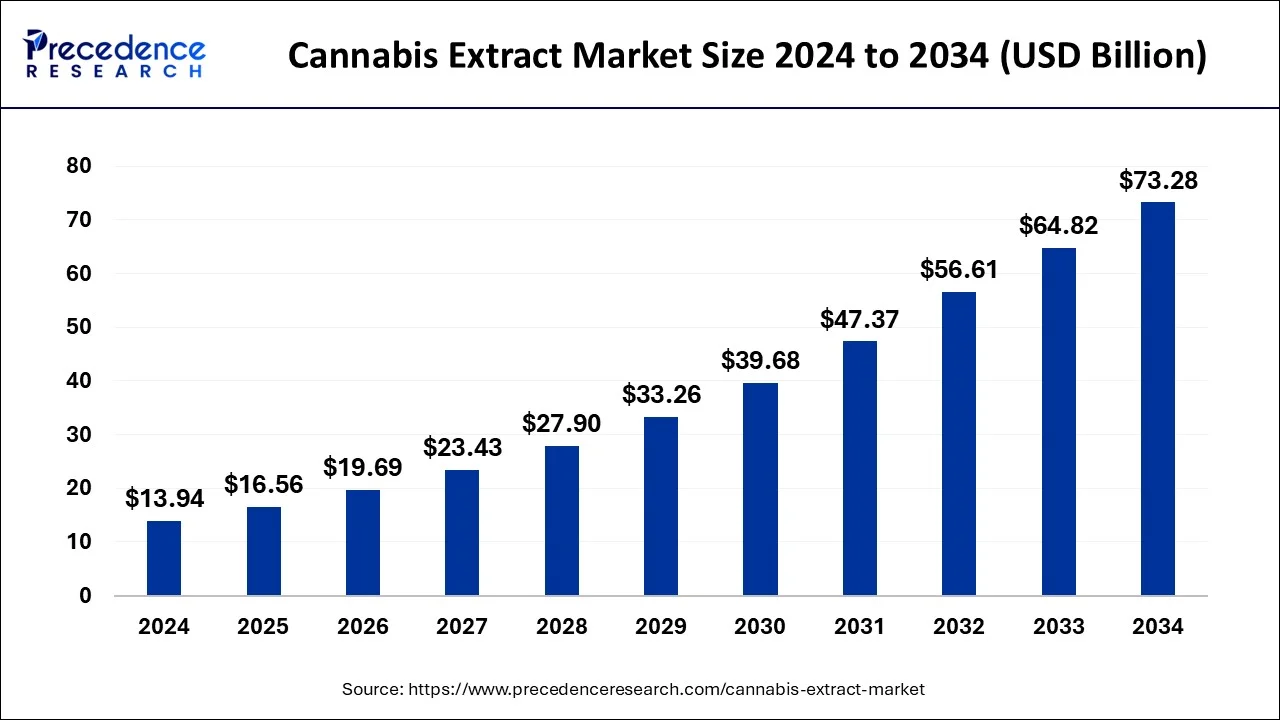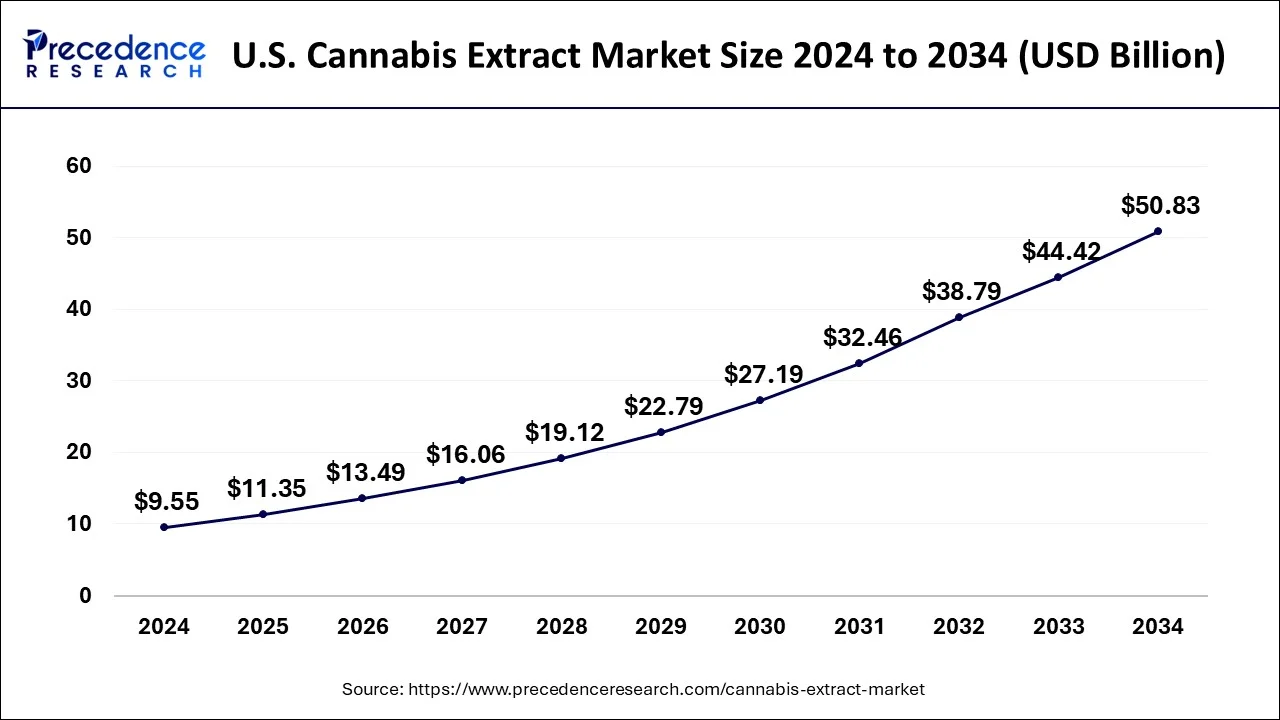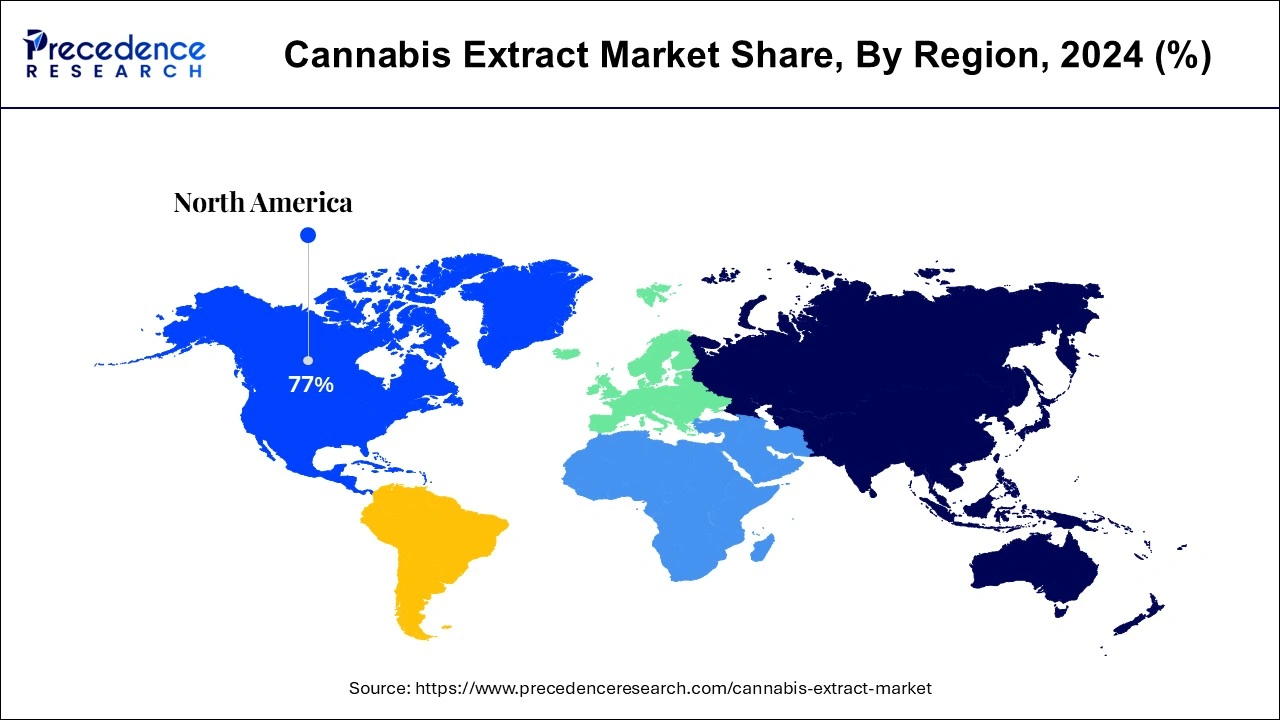November 2024
The global cannabis extract market size is calculated at USD 16.56 billion in 2025 and is forecasted to reach around USD 73.28 billion by 2034, accelerating at a CAGR of 18.05% from 2025 to 2034. The North America cannabis extract market size surpassed USD 10.73 billion in 2024 and is expanding at a CAGR of 18.13% during the forecast period. The market sizing and forecasts are revenue-based (USD Million/Billion), with 2024 as the base year.
The global cannabis extract market size was estimated at USD 13.94 billion in 2024 and is anticipated to reach around USD 73.28 billion by 2034, expanding at a CAGR of 18.05% from 2025 to 2034. The growing awareness about the health benefits associated with cannabis extract is expected to boost the growth of the cannabis extract market during the forecast period.

The integration of artificial intelligence (AI) into the cannabis industry significantly influences the extraction processes for key compounds such as cannabidiol (CBD) and tetrahydrocannabinol (THC). This technological advancement has paved the way for the production of innovative products, including vape oils and a variety of candy edibles. The role of high-tech machinery and sophisticated chemical apparatuses is vital in this transformation. These tools, powered by AI algorithms, enable producers to move beyond traditional extraction methods, which often rely on less efficient, time-consuming techniques. By harnessing AI, companies can optimize their extraction processes, leading to higher yields and improved purity of the extracted cannabinoids. As the cannabis industry continues to evolve, the synergy between AI and advanced extraction technology holds great potential for innovation, efficiency, and product diversity. This revolution not only enhances the quality of cannabis products but also transforms the overall landscape of the market, paving the way for further growth.
The U.S. cannabis extract market size was evaluated at USD 9.55 billion in 2024 and is predicted to be worth around USD 50.83 billion by 2034, rising at a CAGR of 18.19% from 2025 to 2034.

North America dominated the cannabis extract market with the largest share in 2024. This is mainly due to the legalization of cannabis for both medical and recreational purposes. The landscape of the cannabis extract market has changed significantly in recent years as advocacy and public support for cannabis have intensified, placing significant pressure on state legislatures across the U.S. to reconsider their stance on cannabis legalization. There is a high adoption of cannabis extracts for medical purposes, citing a variety of therapeutic benefits. In addition, advocacy groups are actively working to gain legal permission for the smoking purpose.

As of May 2024, a significant milestone has been reached in the U.S., with 38 states and the District of Columbia legalizing marijuana for medicinal purposes. Furthermore, 24 states and the District of Columbia have taken the additional step of allowing adults to use cannabis recreationally. The recreational usage of cannabis is lawful in numerous states, such as Colorado, Alaska, Maine, Illinois, Michigan, Massachusetts, Oregon, Nevada, Washington, Vermont), the District of Columbia, and Guam.
The cannabis extract market is centered around the production and sale of various extracts derived from cannabinoids, the active chemical compounds found within cannabis plants. These extracts are obtained through a variety of methods, each tailored to maximize yield and purity. Common extraction techniques include solvent extraction, which utilizes chemical solvents to separate cannabinoids from the plant material; CO2 extraction, a more advanced method that employs supercritical carbon dioxide to efficiently extract desired compounds; and rosin tech, a solvent-less extraction process that uses heat and pressure to extract oils. The rising usage of cannabis extract in the medical field is expected to fuel the market growth. Cannabis extract can address a variety of health conditions, ranging from chronic pain to anxiety, epilepsy, and sleep disorders.
Cannabis contains over 100 different cannabinoids, each exhibiting unique effects on the human body. Among these, delta-9-tetrahydrocannabinol (THC) and cannabidiol (CBD) stand out as the most prominent and widely utilized extracts in prescription medications, carefully dosed to ensure safety and efficacy. THC is known for its psychoactive properties, offering pain relief and stimulating appetite, while CBD is praised for its non-psychoactive qualities that can potentially reduce anxiety and inflammation. The growing demand for cannabis extracts is driven by their ability to interact with the body’s endocannabinoid system (ECS), a complex network of receptors that plays a vital role in regulating various physiological processes, including pain perception, appetite control, mood stabilization, and sleep regulation. When cannabinoids are ingested through methods such as smoking or vaporizing, they bind to the receptors of the ECS, facilitating a process that promotes balance and homeostasis within the body, effectively enhancing overall well-being. As research continues to shed light on the diverse potential health benefits of cannabis extracts, the market is expected to evolve, offering innovative products and more refined therapeutic options for patients seeking alternative treatments.
| Report Highlights | Details |
| Market Size in 2024 | USD 13.94 billion |
| Market Size in 2025 | USD 16.56 billion |
| Market Size by 2034 | USD 73.28 billion |
| Growth Rate from 2025 to 2034 | CAGR of 18.05% |
| Base Year | 2024 |
| Forecast Period | 2025 to 2034 |
| Segments Covered | Type, Extraction Method, Application |
| Regional Scope | North America, Europe, Asia Pacific, Latin America, Middle East & Africa (MEA) |
Increasing usage in therapeutics
Cannabis extract helps to relieve symptoms such as pain and cramps while also reducing overall discomfort. Additionally, the ability of cannabinoids to improve gastrointestinal motility demonstrates their potential in managing conditions like irritable bowel syndrome or inflammatory bowel disease. As awareness about these therapeutic benefits increases, the market for cannabis extracts is poised for significant growth.
Increased legalization
The legalization of cannabis extract has emerged as a significant catalyst for the growth of the market in recent years. Historically, strict regulations and sanctions about the cultivation of cannabis plants severely limited the use of their extracts, confining them primarily to the medical sector. However, with the progressive shift toward legalization in various countries, there has been a significant expansion in the applications of cannabis extracts. This change not only opens up new opportunities for commercial use across diverse industries, such as cosmetics, food and beverage, and wellness, but it also enhances the availability of products derived from cannabis. As governments recognize the potential benefits of cannabinoids, the legalization of cannabis extract increases.
Stringent regulations
The primary market challenges include government compliance and varying state legalization policies. These legal restrictions significantly hinder the growth of the cannabis extract market, as cannabis has historically been viewed negatively in society. This perception has led to stringent regulations and a slow pace of legalization, impacting both production and distribution. As a result, businesses in this sector grapple with the complexities of navigating legal frameworks, which can differ widely from one state to another, ultimately stifling potential market expansion and innovation.
Proponents of smoking cannabis argue that it can be an effective treatment for a wide range of psychological and medical conditions, including stress, anxiety disorders, chronic pain, and degenerative diseases like Alzheimer’s dementia and Parkinson’s disease. However, it is important to note that despite these claims, there is a limited approvals for cannabis-derived products for these specific uses.
Rising R&D activities
Rising research and development activities to explore the benefits and applications of cannabis extracts create immense opportunities in the market. Various health agencies invest in R&D to develop new products, improve extraction methods, and explore novel uses. For instance, the FDA plays an important role in supporting scientific research into the medical uses of cannabis and its constituents in scientifically valid investigations as part of the agency’s drug review and approval process. As a part of this role, the FDA supports those in the medical research community who intend to study cannabis by providing information on the process needed to conduct clinical research and develop a human drug that is derived from a plant such as cannabis.
The conventional type displayed the major share in the worldwide cannabis extract market in 2022. Increasing applications of cannabis extracts such as CBD oil in pharmaceutical and cosmetic industries is expected to boost the demand for conventional cannabis extracts. The conventional type of cannabis is grown extensively as it enables high production output of cannabis extract.
Cannabis extracts are being used in medications since many years. In 2018, Epidiolex (a seizure medication) became the inaugural Cannabis-derived CBD medication to be permitted in the United States. Moreover, numerous medical formulations comprising of cannabis extract are in the pipeline.
The extraction method which involves the use of solvents is a preferred method of the cannabis extraction industry, especially in manufacturing extracts for personal care ingredients, pharmaceuticals, and food. Some solvents are favored due to their efficiency, effectiveness, and FDA-approval.
The oils segment dominated the cannabis extract market with the largest share in 2024. This is mainly due to their increased use in the treatment for insomnia. Cannabis oils are also used in the treatment of chronic pain, such as arthritis or neuropathic pain, due to their ability to reduce pain. They also regulate sleep and immune-system responses. Moreover, their anti-inflammatory effects make them suitable for various therapeutics.
The tinctures segment is projected to expand at the fastest rate over the studied period. The segmental growth is mainly attributed to their medicinal properties that relieve patients suffering from conditions such as nausea, migraines, or acute pain. Cannabis tinctures are also used in cosmetics and beverages.
The marijuana segment accounted for the largest market share in 2024. This is primarily due to the increased usage of marijuana for medical purposes. It is used in specific amounts in medicines for treating anxiety, stress, and depression. It also has the ability to provide quick relief from chronic pain. Thus, it is also used heavily in chemotherapy.
The hemp segment is expected to grow at a significant pace in the cannabis extract market in the coming years. Hemp extracts are widely utilized for treating a range of health conditions, including managing high cholesterol levels, alleviating constipation, and providing relief from arthritis symptoms, among other conditions. This versatility and potential therapeutic benefits of hemp in holistic wellness practices make it suitable for various therapeutics.
The full-spectrum extracts segment led the market in 2024 by capturing the largest share, primarily because it offers an entourage effect. This effect refers to the synergistic interaction between terpenes and cannabinoids, where their combined presence enhances the therapeutic properties of the cannabinoids. This synergy allows for a more effective delivery of the beneficial compounds found in cannabis, maximizing their potential for therapeutic use by leveraging the full range of available components.
The cannabis isolates segment is projected to grow at the fastest rate throughout the forecast period. Cannabis isolates are produced through advanced isolation and extraction techniques, resulting in pure cannabinoids that are free of other plant compounds. This purification process ensures that users receive highly concentrated forms of cannabinoids, making isolates a dependable choice for those seeking specific therapeutic effects. However, it is important to note that while cannabis isolates provide a potent source of individual cannabinoids, they generally offer fewer health benefits compared to full-spectrum cannabis extracts. Full-spectrum extracts retain a wider array of beneficial compounds, including terpenes and other cannabinoids, which can contribute to the entourage effect where these compounds work synergistically to enhance the overall therapeutic experience. Moreover, isolates are favored for their precision and potency.
The medical use segment dominated the market in 2024. This is mainly due to the increased use of cannabis extract in various therapeutics. Moreover, the rise in the approvals of cannabis-derived products for therapeutic purposes bolstered the segment. For instance, in October 2024, the U.S. FDA approved Epidiolex, which contains a purified form of cannabidiol (CBD) for treating seizures associated with Lennox-Gastaut syndrome or Dravet syndrome in patients 2 years of age and older. The agency also approved Marinol and Syndros for therapeutic uses in the U.S., including for the treatment of anorexia associated with weight loss in AIDS patients and nausea associated with cancer chemotherapy. Marinol and Syndros contain the active ingredient dronabinol, a synthetic delta-9- tetrahydrocannabinol (THC) which is considered the psychoactive intoxicating component of cannabis.
By Product Type
By Extract Type
By Source
By End-use
By Geography
For inquiries regarding discounts, bulk purchases, or customization requests, please contact us at sales@precedenceresearch.com
No cookie-cutter, only authentic analysis – take the 1st step to become a Precedence Research client
November 2024
August 2024
October 2024
February 2025